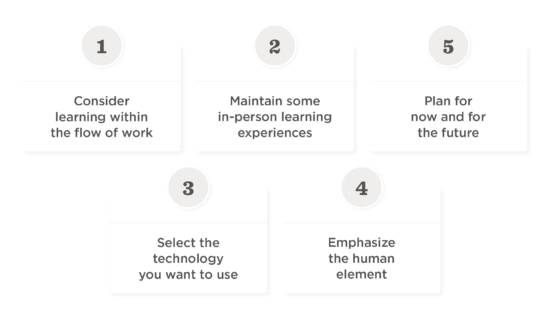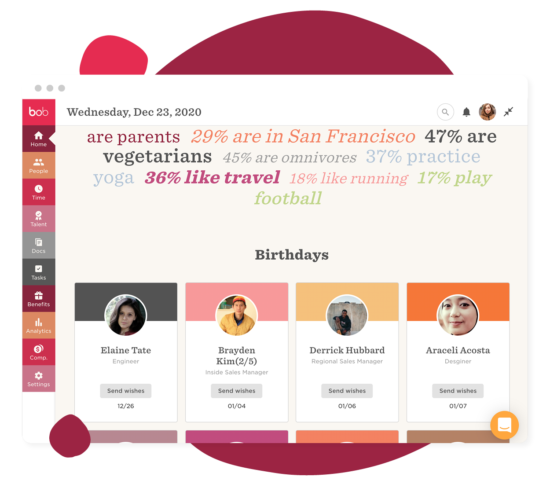The COVID-19 pandemic illustrated just how important it is for companies to have a remote learning and development (L&D) program in place.
“I believe that the crisis has been a really good opportunity to be able to shift some of those mindsets [about traditional learning formats]. And actually, I don’t believe people will ever go back to fully learning in the way they did before. I do believe that’s been disrupted forever. I think those have been some of the opportunities,” Claire Tunley, CEO of the Financial Services Skills Commission, said in a recent webinar.
A further illustration of the uptick in virtual learning is the increased use of web conferencing platforms such as Zoom. During the pandemic, use has soared; VentureBeat reports that Zoom’s daily users jumped from 10 million to over 200 million in just three months. Indeed, everything from team meetings to employee coffee hours and training workshops has moved to a virtual format.
The enthusiasm and wide adoption of new learning formats during this crisis is something to applaud; however, experts advise that organizations need a strategic plan for remote learning for long-term success.
“Mistake number one is taking an interactive, instructor-led classroom program and turning it into a presentation-style webcast. That happens if you are short on design time or if you don’t have skilled designers who are able to thoughtfully repurpose the program,” according to the Association for Talent Development (ATD).
“While it may be tempting to just take the program slides and dump them into an online classroom, don’t. Keep in mind that you are converting a training program, not a presentation. Just because participants are dispersed doesn’t mean that your live online class should be a lecture.”
Of course, it’s not advisable to “dump” employees into an online classroom, but online learning offers numerous benefits when you make a plan for it. With dispersed workforces rapidly becoming the new norm for many organizations, online learning is an effective way to reach more learners and expand professional development opportunities.
As you look to implement remote learning for the long-term—not just as a stop-gap during a pandemic—consider the benefits it offers, the challenges you might encounter, and the strategy you need to make virtual learning work for your employees and organization.
With a thoughtful approach, a virtual L&D program becomes an investment that will ultimately help your company navigate difficult times and allow the organization to adapt to the changing nature of work successfully.

Five significant benefits of remote L&D
1. Cost and time savings
Online, remote training minimizes travel, meals, classroom maintenance, printed materials, and staff salaries that are part of the in-person training budget. It’s much easier to reduce the costs associated with updating existing training and producing new learning materials—which can be expensive and time-consuming for in-person content.
The data you need: According to one report, e-learning reduced professional services firm Ernst & Young’s training expenses by 35 percent. Adopting a blended learning approach (in-person and online content) enabled them to cut their total training hours by 53 percent.
2. Talent attraction
Today’s employees have a desire for development. Part of their development is career advancement, but it’s also developing the skills and abilities that contribute to a better work experience and personal learning. When employers offer development opportunities, they see better results in recruiting and attracting top talent to the organization.
The data you need: According to a 2019 Hiring Trends Report by The Muse, learning and growth opportunities and work-life balance were the two most important things job seekers want from an employer.
3. Accessibility
Adult learners benefit from and seek out flexible and accessible online learning options. Whether using alt text to understand images, increasing the readability of text, or pausing a course midstream to take a break, remote learning is very adaptable to learner needs. Employees can also learn at their own pace, access the learning content for ongoing reference—and do so on their schedule and from any location.
The data you need: Between the end of March and early April 2020, web searches for terms such as “online learning” and “e-learning” increased fourfold in Canada, France, Italy, the United Kingdom, and the United States. In Belgium, the number of participants in the Public Employment Service’s online training was four times as high as the prior year.
4. Engagement
Just as learning and development help organizations attract talent, it also remains a top driver of employee retention engagement. Including remote options is key to enabling this retention driver. Remote L&D can also help ensure all employees have access to development opportunities, which allows the organization to create a bench of talent for long-range succession planning.
The data you need: In response to Udemy’s Workplace Boredom Study, 80 percent of employees said that “learning new skills would make them more engaged at work.”
5. Environmental benefit
There are financial and environmental costs associated with in-person learning. Whether it’s the upkeep of a training site or travel to a place for training, these in-person training costs don’t exist when courses are delivered remotely. By limiting in-person offerings, companies can support their corporate sustainability efforts.
The data you need: One study of the environmental impact of various instruction methods found that distance learning resulted in “an average of 90 percent less energy and 85 percent fewer CO2 emissions per student than conventional face-to-face courses.”
These benefits don’t happen without effort. To experience the full value of remote learning, each organization must create and adopt a remote learning and development plan that works for them.
A strategic approach to remote L&D
A solid remote learning and development strategy requires more than just an online onboarding course or a required compliance course. Many organizations are faced with the realities of a remote workforce during the pandemic already embedded in many organizations, according to Lee-Anne Vallée, a senior director in Gartner’s HR Practice. In her experience, “Many organizations have prioritized building a culture of learning and have successfully leveraged technology to bring the digital experience to the world of L&D.”
When COVID-19 arrived worldwide, organizations with remote learning strategies in place adapted as needed. Without the constraints of learning being on-site or in-person activity, these companies could provide real-time training based on an evolving “new normal.” They were also better prepared to help provide training that allowed employees to develop the skills required to adjust during the pandemic.

A Gartner survey of 113 learning professionals “revealed that 50% to 60% of respondents reported that their workforce has had to use new skills in response to the COVID-19 pandemic,” according to Vallée. The survey also found that nearly six out of 10 L&D professionals had the opportunity to create new training in response to the pandemic.
Providing opportunities for remote learning activities should be a core component of your overall development strategy and a way to infuse a culture of learning throughout your entire organization.
If remote L&D is a new concept for your organization, keep in mind that it takes time for employees to adapt. Some may even have bad experiences from the past that make them hesitant to adopt this new learning style. It will be crucial to communicate with employees about remote learning as an option and practice. Establish a robust remote learning orientation to explain how remote learning works and to set expectations for participants. It’s also essential to gather real-time feedback and insights about participant experiences with the remote learning programs you offer.
Five steps to a successful remote L&D plan

When planning your remote learning and development approach, here are five steps for a successful strategy and implementation of your plan.
Step one: Consider learning within the flow of work
Many organizations are finding success by striving to provide continuous learning opportunities and look for ways to embed informal learning into their everyday workflow. Companies like Google are focusing on creating a learning-centered work culture. Training and development isn’t something that happens apart from an employee’s job.
A study of 700+ organizations conducted by Josh Bersin showed that the average employee only has 24 minutes a week available for “formal learning.” With workers having such a limited amount of time outside of job duties, shifting learning to occur in the flow of work is necessary.
“To help our people learn faster, we are disrupting how we manage learning and development to focus more on the immediate business context and personalized needs by providing easy access to information, performance support aids, and carefully curated training that is relevant and can be directly applied to work,” according to Ann Schulte, Chief Learning Officer at Procter & Gamble (P&G).
Act now: Look for opportunities to infuse short learning activities or revise existing courses into micro-content pieces that employees can access during the flow of work. This approach is imperative, especially while managing a remote workforce who can’t access in-person advice or training.
Step 2: Maintain some in-person learning experiences
It’s essential to determine what learning your organization wants to deliver online and on-demand and what should remain in-person instruction. You may find cultural orientation elements or specific work tasks that don’t lend themselves to an online format. In those cases, consider how you might make a virtual offering work or implement blended learning to cover some of the topics in person.
While it may be tempting to “throw everything on the learning platform,” the reality is that, depending on your industry and the specific roles, a blended approach may be more effective. Combining traditional face-to-face training with virtual learning has been shown to have advantages over purely online instruction.
Act now: Survey your employees—either formally or informally—and ask them what in-person training they believe could be delivered via a remote learning format. Your audience of learners has a unique and relevant perspective, which may help you uncover some innovative ideas.
Step 3: Select the technology you want to use
The cornerstone of delivering remote learning is technology. When researching new software and systems, there are three essential factors to consider:
- Is it integrated? The ability to integrate your learning and development system with other business software will be crucial for successful implementation and improving efficiency and communication.
- Is it simple to use and engaging? An engaging, intuitive, and easy-to-understand platform will make it more appealing to your employees. Systems that provide incentives and recognition are highly effective. And gamification has been shown to improve training content retention rates.
- Does it work? The technology needs to be easy to access so that workers can quickly find the content they need. It should also be an integrated LMS that enables your company to capture training completion rates and quickly analyze skills. This feature helps to ensure that employees reach their potential.
Act now: Reach out to your peers in other companies and ask them about their systems for remote learning. Then use the questions above to evaluate each method. Set up a demo or consultation call to learn more about any systems that seem like they could be a good fit for your organization’s current and future needs.
Step 4: Emphasize the human element
Virtual learning and development still requires the human element. A remote L&D program must include both social and interactive aspects. Utilizing an integrated LMS that includes mentoring, coaching, and communication features will encourage feedback and promote collaboration.
Managers can do their part to help ensure the success of remote learning by holding “remote office hours” and informal team chats and reassuring workers that they can and will learn via online methods. Remote learning can even create situations to interact with new colleagues they may not have a chance to meet in person.
Act now: Take stock of your current programs to evaluate if they include enough opportunities for learners to interact. With some creative design, learning programs can provide a way for employees to attend and collaborate within live sessions, chat, or leave comments on message boards.
Step 5: Plan for now and for the future
Learning and development is continually evolving—in terms of content and the way the content is delivered. COVID-19 helped illustrate that organizations with a comprehensive online learning strategy in place had an easier transition to an entirely remote-based model. As we look to the future, remote learning and development provides ample opportunities for innovation.
There are many possibilities when it comes to delivering remote learning and development. Industries such as healthcare, construction, and hospitality utilize virtual reality (VR) technology in their training programs. Many tech companies are offering online fast-track technical credential programs and “Nanodegrees” to their workforce. These approaches highlight just how technology can help you create remote learning that enhances the employee experience.
Act now: Don’t be afraid to think outside the box when developing your strategy. Conduct a brainstorming session with the L&D team and invite members to dream of what might be possible. Tap into your team’s inspiration and imagination to get the ideas that will help you ensure your organization is prepared for remote learning today and in the future.
Recommended For Further Reading
Conclusion
Organizations want learners to make time for learning. And learners want to learn at their own pace. Now is the optimal time to put those desires to work in a remote learning and development plan.
When it comes to remote learning and development, the most successful organizations will be those that apply what they’ve learned from the pandemic and follow the steps for creating a thoughtful, strategic remote L&D program.
A remote learning plan is not just a reaction to the changing nature of work but an investment that will truly inspire and drive employees learning and provide opportunities for future growth.
Meet Bob

Bob is designed and developed for the new world of work. Onsite, hybrid work, and remote HR leaders can drive culture, two-way communication, engagement, performance, and compensation. Bob’s innovative UI, automated processes, and integrations with leading third-party tools ease administrative tasks for everyone across the organization and make even the most mundane work tasks pleasant, intuitive, and engaging—and not just for HR admins. Bob puts people first with culture tools that connect co-located and remote employees to their fast-growing, global companies.
